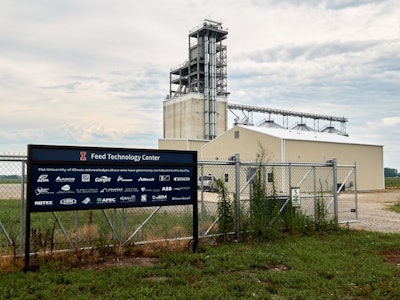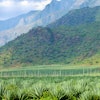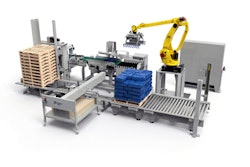
Fully automated, state-of-the-art feed mill at the University of Illinois gives students hands-on experience.
PODCAST: Feed Technology Center focuses on research, teaching (8:22)
Ann Reus: Hello and welcome to the Feed Strategy podcast. I’m your host, Ann Reus.
The Feed Technology Center at the University of Illinois, which began operations in March 2021, replaced a nearly 100-year-old facility on campus.
Plans for the fully automated, state-of-the-art facility had existed for more than 20 years, but the funding had not been available until September 2018, when the university entered into a public-private partnership, similar to a lease-to-own arrangement, that enabled the project to proceed quickly. Construction began in June 2019.
I recently had the opportunity to visit the new feed mill and chat with Maria Godoy, associate professor in the Department of Animal Sciences and Division of Nutritional Sciences and Feed Technology Center fellow. Here’s an excerpt of our conversation.
Tell me about what the Feed Technology Center does.
Maria Godoy: Sure, so the FTC is a new newly built facility, it’s state-of-the-art, that is located here in the ACES legacy corridor in the College of Agriculture, Consumer and Environmental Sciences (ACES). This facility was really built to accelerate advancements and expand our reach and technology, and scientific discovery relating ingredient and feed utilization, new processing methods that can be used, and also to improve efficiency of food production. Ultimately, our goal is to become a national hub for the animal food and ag industries. And this facility has several capabilities, including drying and storage of whole grains, milling, mixing, pelleting, crumbling and extrusion. So the breadth of different processing methods, combined with the automation system that is in place, as well as the inline NIR system, really provide this a conducive environment to teach current and future generations of professionals and students, as well as to help our three main pillars of a land grant institution, which is research, teaching and outreach.
Reus: How was the center funded, and when did it open?
Godoy: So the construction of the Feed Technology Center was made possible by a public-private partnership. The University of Illinois and the College of ACES committed $6 million to this facility as part of their longstanding commitment to the animal industry. And then partnerships with individuals, and also corporate donors, made up the additional cost of construction and equipment. And that really allowed us to have the facility that we have now. And the FTC open about a year ago. The first several months were mostly focused on learning how to operate the facility and all the different pieces of equipment and software. As you may imagine, we moved away from our 100-year-old facility to this facility now that it has all the whistles and bells, so felt a little bit about like riding a horse and now going to a spaceship. But in the last six months, we feel much more comfortable about operating the facility and we’re really looking into expanding our current projects and engaging with larger research projects. Because, so far, we have been really focused on producing diets for the farm animals, as well as smaller research projects.
Reus: Can you tell me about some of those research projects that you’ve done so far at the FTC?
Godoy: Sure, we have worked with several faculty members, mainly producing mash diets at this point for non-ruminant and ruminant species. Those projects could be anywhere from mixing complete and balanced diets to grinding diets to a specific particle size. It really varies based on the research needs of different laboratory groups. In every project, we also have been able to learn more about the best way to operate the facility and to attend to the needs of our faculty, and research collaborators. We recently commissioned the pelleting machine and extrusion system. So, beginning this fall, we plan to expand our capabilities on those fronts as well.
Reus: Has the animal nutrition curriculum at the University of Illinois been expanded as a result of the new center?
Godoy: Yes, it has so far and there is some work still to be done. So for current courses, there are courses in agriculture and biological engineering, as well as in animal sciences, that have already leveraged this facility to better teach concepts in their courses. But we’re also working on developing new courses to create a minor in feed sciences, as well as short courses that will cover processing methods, food safety, among other things. So I think there’s a lot of potential to expand. We also have new programs that can greatly benefit from the FTC, from this facility. So our undergraduate students have the option to do a four-plus-one master’s program, which allows them to earn a bachelor’s and a master’s degree only five years. And so, for example, if they’re interested in feed science, or animal nutrition, this is certainly something that the FTC can help them to gain that knowledge. We also have a new bachelor’s program that is a hybrid degree between computer science and animal sciences. So a lot of the big data that can be generated at the Feed Technology Center can also be leveraged for training of the students in how to use computer science using a more agricultural platform. We also have developed several certificate programs. And, certainly, we’re looking into developing a few more leveraging the FTC capabilities. We also wanted to focus on not only traditional students but also non-traditional students. And so give them an opportunity to receive continuing education through workshops and short courses, either in person or online. So there’s a lot of moving parts, and that is what we’re planning to do in the next few years.
Reus: What kind of feedback have you gotten from students who use the center?
Godoy: I think overall, the students are really excited to have this facility on campus and have the opportunity to gain hands-on experience. Oftentimes, when students want to learn about processing, it is really difficult to visualize until you have an opportunity to experience, to see and kind of being able to dial up and dial down a lot of different buttons and things like that. So I think has been really exciting. Of course, this is something that we didn’t have on campus, so has also been a cultural change for our students, because before this is something that they wouldn’t even consider. So now we’re really bringing a lot of students to the facility, providing a lot of tours, so they get exposed to that facility and they see all the different capabilities and how that fits within their majors and career aspirations so they can get more involved. So, currently, we have employed about four to five undergraduate students during the fall and spring semesters. And we aim to have a larger pool of undergraduate students working with us at this facility through their experiential learning, which is a requirement for our animal sciences students, undergrad students. And also we have the non-thesis masters students that also have a research component so they could also use that facility to gain that experience.
Reus: I’d like to thank Maria Godoy and facility manager Leon Peters for letting me tour the Feed Technology Center and for taking the time to talk with me. You can learn more about the University of Illinois Feed Technology Center in the September/October issue of Feed Strategy and the August issue of Feed Mill of the Future. Make sure you receive all the latest information from Feed Strategy by visiting FeedStrategy.com to register and subscribe.
Thank you for listening. I’m Ann Reus for Feed Strategy.















